 Morphological variability of the trace fossil Schaubcylindrichnus coronus as a response to environmental forcing
Morphological variability of the trace fossil Schaubcylindrichnus coronus as a response to environmental forcing
Article number: 16.1.5A
https://doi.org/10.26879/327
Copyright Palaeontological Association, January 2013
Author biographies
Plain-language and multi-lingual abstracts
PDF version
Submission: 11 May 2012. Acceptance: 14 January 2013
{flike id=382}
ABSTRACT
Schaubcylindrichnus is an important trace fossil used in the characterization of offshore and shoreface depositional environments. Our understanding of this trace has followed a winding path including the introduction of several new ichnospecies and the subsequent recent synonymization into one ichnospecies. Likewise, our understanding of the ethological interpretation of the trace fossil has evolved from gregarious head-down deposit feeders to filter feeders, until it recently was shown that the tracemaker probably was a funnel feeder. Although several ichnospecies were recently synonymized into one ichnospecies, Schaubcylindrichnus coronus, variability in the number of tubes per sheaf and abundance of nested tubes, i.e., tubes that break up older tubes, were observed between different settings. These differences were studied in close detail at Miocene outcrops in Japan and Taiwan where the trace fossil occurs copiously and therefore allows the intraspecific morphological variability to be addressed. Around 2000 specimens from Japan and Taiwan were studied. The results show a distinct tendency for higher tube numbers in the offshore facies where sediments are characterized by higher silt/mud content, suggesting that S. coronus with higher tube numbers were constructed in a calm environment allowing longer dwelling periods. The increased abundance of nested tubes in settings characterized by thin sand layers indicate that the nested tubes are a reparation response to erosional events destroying the feeding funnels at the sediment-water interface. Consequently, tube number per sheaf and abundance of nested tubes may be used to further characterize the depositional environment in shoreface to offshore facies.
Ludvig Löwemark. Department of Geosciences, National Taiwan University, No 1. Sec. 4 Roosevelt Road, P.O. Box 13-318, 106 Taipei, Taiwan
Masakazu Nara. Department of Natural Science, Kochi University, Kochi 780-0815, Japan
Keywords: Trace fossils; Schaubcylindrichnus coronus; sheaf, lined tube; funnel feeder
Final citation: Löwemark, Ludvig and Nara, Masakazu. 2013. Morphological variability of the trace fossil Schaubcylindrichnus coronus as a response to environmental forcing, Palaeontologia Electronica Vol. 16, Issue 1; 5A 14p. https://doi.org/10.26879/327
palaeo-electronica.org/content/2013/382-schaubcylindrichnus
INTRODUCTION
The trace fossil Schaubcylindrichnus coronus Frey and Howard 1981 consists of a sheaf of lined tubes, each of which shows an upward curving in both ends. In well preserved specimens, a funnel can be seen in the proximal end and a mound-like structure in the distal end. Tubes within one sheaf can vary from being almost parallel in the horizontal plane to diverging at angles up to 90°. The sheaves typically contain 2-10 tubes, but up to 30 tubes in one sheaf have been observed. Single tubes presumably exist, although it is difficult to determine whether these tubes are truly singular tubes or simply an effect of erosion and exposure (Frey and Howard, 1981; Frey and Pemberton, 1991; Miller, 1995b; Löwemark and Hong, 2006; Nara, 2006).
 The morphological, taxonomical, and ethological interpretations of the ichnogenus Schaubcylindrichnus have varied considerably over time. After early studies referred to the trace fossil in terms of "plural curving tubes" (e.g., Howard, 1966; Chamberlain, 1976), it was formally described as Schaubcylindrichnus coronus: A bundle or sheaf of congruent, curved tubes (Frey and Howard, 1981). Initially the trace was believed to be confined to Cretaceous strata from the Western Interior of North America, but later it was described from an increasing number of locations of different ages (see overview by Löwemark and Hong, 2006). Parallel to the use of the ichnogenus Schaubcylindrichnus, the ichnogenus name Terebellina has been used to describe single tubes and loose clusters of lined, curved tubes (e.g., MacEachern and Burton, 2000; Savrda and Nanson, 2003; MacEachern and Hobbs, 2004). However, in 1995, Miller demonstrated that the type specimen of Terebellina is actually a large agglutinated foraminifera of the genus Bathysiphon. Miller (1995a) further introduced a new ichnospecies, S. freyi Miller 1995 for loosely clustered bundles of lined tubes found in Pleistocene outer shelf rocks. Löwemark and Hong (2006) continued this trend of distinguishing new ichnospecies within the genus Schaubcylindrichnus by describing S. formosus Löwemark and Hong 2006 from Miocene strata in northern Taiwan (Figure 1).
The morphological, taxonomical, and ethological interpretations of the ichnogenus Schaubcylindrichnus have varied considerably over time. After early studies referred to the trace fossil in terms of "plural curving tubes" (e.g., Howard, 1966; Chamberlain, 1976), it was formally described as Schaubcylindrichnus coronus: A bundle or sheaf of congruent, curved tubes (Frey and Howard, 1981). Initially the trace was believed to be confined to Cretaceous strata from the Western Interior of North America, but later it was described from an increasing number of locations of different ages (see overview by Löwemark and Hong, 2006). Parallel to the use of the ichnogenus Schaubcylindrichnus, the ichnogenus name Terebellina has been used to describe single tubes and loose clusters of lined, curved tubes (e.g., MacEachern and Burton, 2000; Savrda and Nanson, 2003; MacEachern and Hobbs, 2004). However, in 1995, Miller demonstrated that the type specimen of Terebellina is actually a large agglutinated foraminifera of the genus Bathysiphon. Miller (1995a) further introduced a new ichnospecies, S. freyi Miller 1995 for loosely clustered bundles of lined tubes found in Pleistocene outer shelf rocks. Löwemark and Hong (2006) continued this trend of distinguishing new ichnospecies within the genus Schaubcylindrichnus by describing S. formosus Löwemark and Hong 2006 from Miocene strata in northern Taiwan (Figure 1). 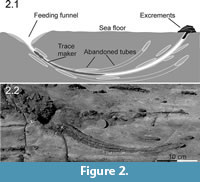 At the same time, Nara (2006) performed detailed studies on Schaubcylindrichnus found in Cenozoic strata of Japan, and by comparing this material with holo-, para-, and topotype material of S. coronus and S. freyi, he concluded that S. freyi can be accommodated within the original ichnospecies after a revision of the basic morphological traits was made. This synonymization culminated in 2010 when Löwemark and Nara (2010) were able to compare their results and it was shown that S. formosus is a junior synonym of S. coronus. In the thousands of specimens studied, the true endings of the tube could only be observed in a very limited number of cases due to erosion, bioturbation, and exposure. Although few, these observation strongly support the funnel and mound morphology of the trace fossil.
At the same time, Nara (2006) performed detailed studies on Schaubcylindrichnus found in Cenozoic strata of Japan, and by comparing this material with holo-, para-, and topotype material of S. coronus and S. freyi, he concluded that S. freyi can be accommodated within the original ichnospecies after a revision of the basic morphological traits was made. This synonymization culminated in 2010 when Löwemark and Nara (2010) were able to compare their results and it was shown that S. formosus is a junior synonym of S. coronus. In the thousands of specimens studied, the true endings of the tube could only be observed in a very limited number of cases due to erosion, bioturbation, and exposure. Although few, these observation strongly support the funnel and mound morphology of the trace fossil.
The early studies interpreted the congruent bundle of tubes to be the work of gregarious head-down (conveyor-belt) deposit feeders (Frey and Howard, 1981; Frey and Pemberton, 1991). This interpretation was discredited by Nara's (2006) discovery that the tubes of individual bundles show clear size gradation and that the upper ends of the U-shaped tube system are attached to a funnel and a mound-structure (Figure 2). Schaubcylindrichnus is now considered to be the burrow of a solitary funnel feeder (Nara, 2006; Löwemark and Nara, 2010).
The trace fossil Schaubcylindrichnus has become an important tool to help characterize different depositional settings in nearshore to inner shelf settings (Pemberton et al., 2001). However, the usefulness is complicated by occurrences of Schaubcylindrichnus in atypical environments such as outer-shelf (Miller, 1995b), offshore (Nara, 2006), slope (Blissett and Pickerill, 2003), or even deep-sea fan settings (Pliocene Kiyosumi Formation, Japan: Nara, unpubl. data). Furthermore, it is not well constrained how observed differences in parameters such as tube size, tube number, and arrangement are related to variations in environmental factors. Löwemark and Nara (2010) mentioned the possibility that the number of tubes per sheaf might be developed as a quantitative proxy for variability in wave or current action, speculating that the number might reflect how often the structure had to be reconstructed after erosional events.
The aim of this study is to address how the perceived variations in trace fossil morphology are related to environmental variations. Specifically, the significance of two morphological traits will be addressed. First, whether higher tube numbers per sheaf can be attributed to prolonged times of occupation, or if higher tube numbers represent a reparation response to erosional events. Second, is the abundance of nested tubes related to the frequency of erosional events? The rationale is that high-energy events such as storm deposits would result in erosion of the upper parts of the burrow systems, initiating reparation activities by the producer that lead to an increased breaking up of older tubes as new ones are constructed. If these hypotheses hold true, it would mean that tube number per sheaf and the abundance of nested tubes could be developed into a proxy for bottom water energy levels in the shelf system. A better understanding of this trace fossil will significantly improve facies interpretations needed to characterize oil source- and reservoir rock, as well as paleoenvironmental interpretations.
DEPOSITIONAL SETTINGS
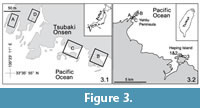 Japan
Japan
The observations were made near the Tsubaki Onsen (Tsubaki hot springs) of Shirahama Town, Wakayama Prefecture, Central Japan, where a Miocene forearc basin fill of the Shirahama Formation crops out (Figure 3.1). The Tsubaki Onsen section is interpreted to have been deposited in wave-dominated shallow marine settings. In the section, four sub-sections were studied spanning from lower offshore to the offshore transition zone (Figure 4).
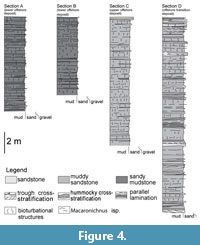 Lower offshore sediments consisting of totally bioturbated sandy mudstones with minor amount of thin, very fine-grained sandstone sheets showing parallel-stratification, were found at sections A and B. The totally bioturbated mudstones of section A showed the finest grain size among the Japanese sections, and commonly contained no discrete trace fossils except for Schaubcylindrichnus coronus and few specimens of Phycosiphon incertum Fischer-Ooster 1858[AUTHOR: need full reference for reference list], Teichichnus isp and unnamed oblique burrows. In contrast, bioturbated mudstones of section B yield several trace fossils including S. coronus, Scolicia isp.
Lower offshore sediments consisting of totally bioturbated sandy mudstones with minor amount of thin, very fine-grained sandstone sheets showing parallel-stratification, were found at sections A and B. The totally bioturbated mudstones of section A showed the finest grain size among the Japanese sections, and commonly contained no discrete trace fossils except for Schaubcylindrichnus coronus and few specimens of Phycosiphon incertum Fischer-Ooster 1858[AUTHOR: need full reference for reference list], Teichichnus isp and unnamed oblique burrows. In contrast, bioturbated mudstones of section B yield several trace fossils including S. coronus, Scolicia isp.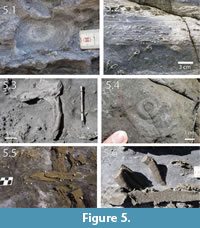 De Quatrefages, 1849, Teichichnus isp. and Thalassinoides isp. (Figure 5). A laminated sandstone layer of this section contains Macaronichnus isp. sensu Seike et al. (2011). Upper offshore sediment consisting of intensely bioturbated muddy sandstones with intercalated very fine- to fine-grained, thin sandstone sheets showing parallel-stratification were observed in section C. The trace fossils Phycosiphon incertum, Rosselia socialis Dahmer 1937, Scolicia isp. and Thalassinoides suevicus Rieth 1932 co-occur with S. coronus in this section. Offshore-transition zone sediments of interbedded bioturbated muddy sandstones and hummocky or trough cross-stratified sandstones were recognized at section D. Some of the hummocky cross-stratified sandstones contain abundant specimens of Macaronichnus isp. (cf. Seike et al., 2011).
De Quatrefages, 1849, Teichichnus isp. and Thalassinoides isp. (Figure 5). A laminated sandstone layer of this section contains Macaronichnus isp. sensu Seike et al. (2011). Upper offshore sediment consisting of intensely bioturbated muddy sandstones with intercalated very fine- to fine-grained, thin sandstone sheets showing parallel-stratification were observed in section C. The trace fossils Phycosiphon incertum, Rosselia socialis Dahmer 1937, Scolicia isp. and Thalassinoides suevicus Rieth 1932 co-occur with S. coronus in this section. Offshore-transition zone sediments of interbedded bioturbated muddy sandstones and hummocky or trough cross-stratified sandstones were recognized at section D. Some of the hummocky cross-stratified sandstones contain abundant specimens of Macaronichnus isp. (cf. Seike et al., 2011).
Taiwan
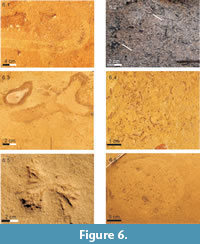 Although Schaubcylindrichnus has been described from Oligocene to Pliocene sediments in Taiwan, the most abundant and best exposed occurrences are found in the Yehliu Sandstone Member of the Miocene Taliao Formation at Yehliu Peninsula and Heping Island on the northeast coast (Löwemark and Hong, 2006) (Figure 3.2). The Yehliu Sandstone Member is an offshore to shoreface succession of facies dominated by Schaubcylindrichnus coronus, although Ophiomorpha isp. Phycosiphon incertum, Macaronichnus segregatis Clifton and Thompson 1978, and Bichordites isp. are also abundant (Figure 6). Body fossils in the sandstones consist of molluscs, echinoid, and bryozoans. Oysters are found in situ in certain thin lenses of fossil rich sediment and irregular sea urchins, presumably also preserved in situ, are found throughout the sandstone member (Ho et al., 1964; Hong and Wang, 1988).
Although Schaubcylindrichnus has been described from Oligocene to Pliocene sediments in Taiwan, the most abundant and best exposed occurrences are found in the Yehliu Sandstone Member of the Miocene Taliao Formation at Yehliu Peninsula and Heping Island on the northeast coast (Löwemark and Hong, 2006) (Figure 3.2). The Yehliu Sandstone Member is an offshore to shoreface succession of facies dominated by Schaubcylindrichnus coronus, although Ophiomorpha isp. Phycosiphon incertum, Macaronichnus segregatis Clifton and Thompson 1978, and Bichordites isp. are also abundant (Figure 6). Body fossils in the sandstones consist of molluscs, echinoid, and bryozoans. Oysters are found in situ in certain thin lenses of fossil rich sediment and irregular sea urchins, presumably also preserved in situ, are found throughout the sandstone member (Ho et al., 1964; Hong and Wang, 1988).
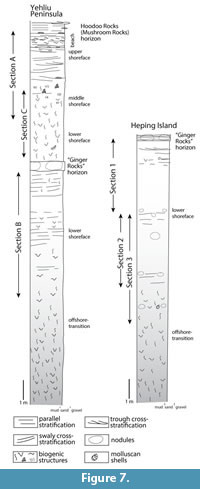 At Yehliu Peninsula three sections were studied (Figure 7). Section A on the northern shore of the peninsula consists of an area characterized by honeycomb weathered, mushroom-shaped hoodoo rocks (Hong and Huang, 2001). The sediment consists of fairly well sorted yellowish sandstone with abundant Ophiomorpha isp. and Phycosiphon incertum. Macaronichnus segregatus abundantly occur in the topmost meter. The presence of M. segregatus in the topmost part of the section suggests a shallow paleoenvironment close to the shore, as M. segregatus is typically restricted to foreshore sediments in modern settings (cf. Seike, 2007). Body fossils of irregular sea urchins are abundant, otherwise body fossils are scarce. Schaubcylindrichnus coronus appears to be more common in the lower part of the section. Section B at the southern side near the tip of the peninsula consists of yellow-gray muddy sandstone stratigraphically situated beneath a ~50 cm thick bed of grayish sandstone weathered into knobby hoodoo rocks locally known as ginger-rocks, because of their resemblance to the rootstocks of the ginger plant. Trace fossils are dominated by Schaubcylindrichnus with some Ophiomorpha. Section C, at the southern side of the peninsula, by a small bay, consists of grayish sandstone rich in mud and silt. Section C is situated stratigraphically above the aforementioned "ginger rock" layer, making section B the deepest setting when compared to sections A and C. The sediments contain only a few other traces, mostly Ophiomorpha nodosa, Phycosiphon incertum, occasional Teichichnus isp., and body fossils of irregular sea urchins.
At Yehliu Peninsula three sections were studied (Figure 7). Section A on the northern shore of the peninsula consists of an area characterized by honeycomb weathered, mushroom-shaped hoodoo rocks (Hong and Huang, 2001). The sediment consists of fairly well sorted yellowish sandstone with abundant Ophiomorpha isp. and Phycosiphon incertum. Macaronichnus segregatus abundantly occur in the topmost meter. The presence of M. segregatus in the topmost part of the section suggests a shallow paleoenvironment close to the shore, as M. segregatus is typically restricted to foreshore sediments in modern settings (cf. Seike, 2007). Body fossils of irregular sea urchins are abundant, otherwise body fossils are scarce. Schaubcylindrichnus coronus appears to be more common in the lower part of the section. Section B at the southern side near the tip of the peninsula consists of yellow-gray muddy sandstone stratigraphically situated beneath a ~50 cm thick bed of grayish sandstone weathered into knobby hoodoo rocks locally known as ginger-rocks, because of their resemblance to the rootstocks of the ginger plant. Trace fossils are dominated by Schaubcylindrichnus with some Ophiomorpha. Section C, at the southern side of the peninsula, by a small bay, consists of grayish sandstone rich in mud and silt. Section C is situated stratigraphically above the aforementioned "ginger rock" layer, making section B the deepest setting when compared to sections A and C. The sediments contain only a few other traces, mostly Ophiomorpha nodosa, Phycosiphon incertum, occasional Teichichnus isp., and body fossils of irregular sea urchins.
At Heping Island three sections were studied. Section 1 and section 2 are situated on a raised wave-cut platform just northeast of the visitor center, while section 3 is situated in the southern part of the park at the base of an escarpment. The three sections studied represent slightly different environments in their offshore to shoreface setting. Section 1 consists of yellow-gray muddy sandstone underlying a thick gray layer of sandstone that preferentially weathers into ginger-like knobs that can be followed over some distance. The sediment contains some Ophiomorpha nodosa and Phycosiphon incertum, as well as some ?Häntzschelina isp. The layers are only weakly inclined, and both bedding plane views and vertical views of the trace fossils are possible. Huge spatial variability of S. coronus was observed. While some areas are completely barren, other areas just meters away may contain high abundances of Schaubcylindrichnus. The higher abundances seem to be linked to a slight color change in the sediment towards greenish and to higher content of silt and mud in the sediment. The differences in mud and silt content are related to differences in bottom water energy levels.
Section 2 is situated directly below section 1, and sediment color has shifted towards light greenish gray. The sediment contains higher amounts of silt and mud and is characterized by copious occurrences of S. coronus, sheaf-densities may reach over 50 sheaves per m2. The number of tubes per sheaf is also higher, maximum number of tubes observed in this area was 25. Section 2 also contains occasional Ophiomorpha isp., oyster valves, and other bivalve remains. Section 3 is situated east of sections 1 and 2, stratigraphically below section 1. Section 3 consists of totally bioturbated, gray, muddy sandstone capped by a layer of ginger-rock. The sediment contains oyster shells together with Ophiomorpha trace fossils and abundant S. coronus.
METHOD
Variations in the number of tubes per sheaf were estimated by counting visible tubes in a number of outcrops in Japan and Taiwan. Only tubes clearly identifiable as Schaubcylindrichnus coronus were counted. It was sometimes difficult to objectively determine whether a set of tubes belong to the same burrow system, or to two nearby systems. Furthermore, due to the curved nature of the tubes, the same tube may be counted twice if it reaches the modern exposed surface at both ends. When feasible, individual strata where recorded separately. The number of tubes per sheaf recorded likely does not reflect the true number of tubes per sheaf, as only tubes exposed by erosion could be observed unless the erosional surface happens to be perfectly perpendicular to the tube system. Consequently, the observed number of tubes per sheaf is strongly biased towards lower values. Despite these limitations we argue that any significant difference in actual tube number per sheaf between two settings should be clearly visible as a significant difference in the distribution of observed tube number between the different settings. Because the recording of trace fossils in the field is to some extent subjective, several areas where reanalyzed during later visits to exclude bias introduced by drifts in the recording technique, personal preferences, fatigue, or weather conditions. This proved particularly important for section B at Yehliu, initially recorded during cold, rainy, and windy conditions. The original measurements made in spring 2011 indicated anomalously low abundance of one-tube systems compared to the other offshore transition sections. However, a thorough reanalysis of the section during fair weather conditions in March 2012 revealed a distribution almost identical to the other offshore transition sections, and we therefore refute the initial measurements as an artifact likely caused by rain obscuring single tubes in particular.
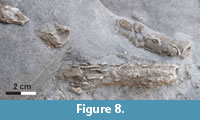 The statistical significance of the differences between the individual sections was tested by paired comparisons of average tube numbers. After applying Bonferroni correction, the differences observed are statistically significant at the 5% level if the p-value is lower than 0.0011 (Table 1).
The statistical significance of the differences between the individual sections was tested by paired comparisons of average tube numbers. After applying Bonferroni correction, the differences observed are statistically significant at the 5% level if the p-value is lower than 0.0011 (Table 1).
In addition to number of tubes per sheaf, it was also noted whether the tubes showed signs of breaking up older tubes, resulting in fragments of older tubes surrounding the central, intact tube, hereafter referred to as nested tubes (Figure 8). Tube systems, or sheaves, were classified as either nested or plain based on the presence of at least one tube in the sheaf showing nesting. In other words, nested or plain appearances were assigned to complete systems. The percentage reported thus does not describe the ratio of nested vs. plain tubes, but rather the percentage of S. coronus sheaves that contain at least one tube that breaks up older tubes.
RESULTS
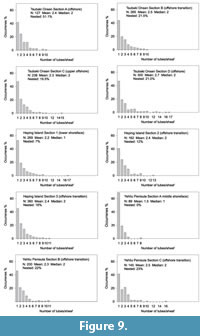 Japan
Japan
In the Miocene Shirahama Formation data were collected from four different depositional environments from offshore settings to the transition zone between offshore and shoreface. A total of 897 sheaves were studied to determine the number of tubes and the ratio of nested tubes. In the analyzed sections, the number of sheaves varied between 1 and 17. In all four settings, single-tube observations are the most common with values around 40%, followed by sheaves of two tubes at about 20% and thereafter a longtail distribution where the number of observations show an exponential decrease asymptotically towards zero (Figure 9). In the two offshore settings, i.e., sections A and D, slight increases in the midrange (4 and 5-6 tubes, respectively) could be indicative of conditions favorable for larger tube numbers per sheaf. Section D also shows more sheaves with many (>10) tubes per sheaf. At this locality, but outside the analyzed area, sheaves with extreme numbers as high as 30 were observed in a few cases.
A pronounced difference was detected in the number of tube systems that contained nested tubes. The offshore section A has a rate of sheaves that contain nested tubes that is over 50%; this is more than twice the number for the other studied areas which have rates of around 20%. The most obvious differences between the settings are the clearly higher mud content and considerably higher frequency of intercalated sand layers at the site with the higher number of nested tubes.
Taiwan
In Taiwan Schaubcylindrichnus was studied in two outcrops of the Miocene Taliao Formation. At both Yehliu Peninsula and at Heping Island three different sections were chosen for detailed studies. In total, 1225 sheaves were studied to determine the number of tubes and the ratio of nested tubes (Figure 9).
At Heping Island, single-tube systems make up over 40% in all three sections and two-tube systems lie around 20%. The distributions of tubes per sheaf follow a longtail distribution asymptotically declining towards zero for higher numbers of tubes. Average tubes per sheaf is similar for all three with values ranging from 2.2 to 2.4, while median numbers of tubes are one for section 1 and two for sections 2 and 3. The largest difference between the sections is found in the number of nested tubes, which rises from 7% in section 1 to 18% in section 3. There is a general connection between number of nested sheaves, Schaubcylindrichnus overall abundance, and the content of mud and silt in the sediment.
At Yehliu Peninsula the studied sections show slightly larger differences than at Heping Island. Although section A displays a longtail distribution similar to the sections at Heping Island, sheaves with only one visible tube make up more than 60% of the sheaves. Two-tube systems make up slightly less than 20% and there are only a few sheaves with higher tube numbers. Consequently, mean and median tube numbers are lower than in any other of the studied sections (1.5 and 1, respectively).
Sections B and C display a longtail distribution similar to the ones found in most other sections with one-tube systems at 40%, mean and median tube numbers at 2.3-2.5 and 2, but with elevated numbers of 3-tube systems at around 20%. The largest differences between the three sections at Yehliu Peninsula are found in the percentage of sheaves containing nested tubes. While no nested tubes were found in section A, section B contains 22% nested tubes and section C 23%.
DISCUSSION AND CONCLUSIONS
The Schaubcylindrichnus producer was a solitary funnel feeder similar to modern ptychoderid enteropneusts (Nara, 2006), and as such depended on bottom water movements as a means of transporting food particles into the vicinity of the funnel. However, energetic bottom waters also mean that the burrow system is subject to repeated erosional events that may destroy the upper parts of the system, as mentioned in Löwemark and Nara (2010). The hypotheses to be tested here is whether a) differences in the energy level of different facies are reflected in reparation activities by the producer, or, as an alternative hypothesis, if b) stable conditions and fewer erosional events would allow the trace maker to construct a larger number of tubes in the same place, resulting in more tubes per sheaf. Consequently, if resolved, the differences in the number of tubes per sheaf, and the percentage of burrow systems showing nested tubes could be developed into independent indicators for the energy level of the environmental setting.
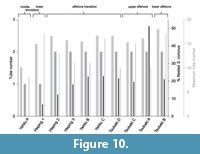 In the Miocene section in western Japan a slight difference between the four settings can be observed with slightly higher frequency in the mid-spectrum (4-6 sheaves) in the lower offshore areas. However, these differences are so small that they do not provide a useful tool for facies interpretation even if they are real. Furthermore, the observed numbers of tubes per sheaf were higher in the deeper and presumably calmer settings, thereby falsifying the first hypothesis. This would then rather suggest that calm conditions allowing the producer to inhabit the same position over an extended period of time favors tube systems with a larger number of tubes. This second hypothesis is also supported by the fact that the offshore setting at section B displays more sheaves with high tube numbers and also contained a few sheaves with extremely high tube numbers (30, the highest number of tubes per sheaf that we are aware of). The Taiwanese sites show a similar pattern. Section A at Heping Island and section A at Yehliu Penisula contain the highest numbers of single-tube systems and are also characterized by the most well-sorted sandstones with the lowest silt/mud content. In contrast, the sections with the lowest number of single-tube systems and the highest number of multiple-tube systems are characterized by sandstones with higher mud content. The compilation shown in Figure 10 displays this fairly clear trend with fewer tubes per sheaf, lower percentage of nested tubes, and lower maximum tube numbers in the shallower, more energetic sites, while the sites distinguished by deeper, calmer paleosettings are characterized by higher average tube numbers per sheaf, larger percentage of nested tubes, and higher maximum tubes per sheaf. However, in some cases, such repeated tube building has also been related to the trace maker's growth (Nara, 2006).
In the Miocene section in western Japan a slight difference between the four settings can be observed with slightly higher frequency in the mid-spectrum (4-6 sheaves) in the lower offshore areas. However, these differences are so small that they do not provide a useful tool for facies interpretation even if they are real. Furthermore, the observed numbers of tubes per sheaf were higher in the deeper and presumably calmer settings, thereby falsifying the first hypothesis. This would then rather suggest that calm conditions allowing the producer to inhabit the same position over an extended period of time favors tube systems with a larger number of tubes. This second hypothesis is also supported by the fact that the offshore setting at section B displays more sheaves with high tube numbers and also contained a few sheaves with extremely high tube numbers (30, the highest number of tubes per sheaf that we are aware of). The Taiwanese sites show a similar pattern. Section A at Heping Island and section A at Yehliu Penisula contain the highest numbers of single-tube systems and are also characterized by the most well-sorted sandstones with the lowest silt/mud content. In contrast, the sections with the lowest number of single-tube systems and the highest number of multiple-tube systems are characterized by sandstones with higher mud content. The compilation shown in Figure 10 displays this fairly clear trend with fewer tubes per sheaf, lower percentage of nested tubes, and lower maximum tube numbers in the shallower, more energetic sites, while the sites distinguished by deeper, calmer paleosettings are characterized by higher average tube numbers per sheaf, larger percentage of nested tubes, and higher maximum tubes per sheaf. However, in some cases, such repeated tube building has also been related to the trace maker's growth (Nara, 2006).
The paired comparison of the average tube numbers per sheaf between the different sections shows that section Yehliu A, in the middle shoreface facies, is significantly different from the other stations (Table 1). As demonstrated in Figure 10, this site differs from the other sites by having the lowest average tube numbers, and also by displaying lowest maximum tubes per sheaf. Furthermore, section A displays very low percentage of nested tubes. The Yehliu A differs from the other shoreface setting, Heping 1, by representing the shallowest paleoenvironment, an upper shoreface facies, as indicated by the presence of Macaronichnus segregatis in the topmost part at Yehliu section A (cf. Seike, 2007; Seike et al., 2011). Thus, the environment at Yehliu A was characterized by higher bottom water energies and a more well-sorted, coarser sediment compared to Heping 1, resulting in less favorable conditions for the producers, shorter inhabitation intervals and fewer tubes per sheaf.
In contrast to the generally small variation in the number of tubes per sheaf, the distinct difference in percentage of tube systems containing nested tubes suggests a response to dissimilarities in either energy level or substrate consistency, or a combination of both. At both the Japanese and the Taiwanese sites, the cracking of older tubes resulting in a nested appearance of the tubes is clearly related to the content of fine-grained material in the sandstone. It is therefore interesting to note that the site containing the highest percentage of nested tubes differs in two parameters from the other sites. First, the lower offshore setting in section A in Japan contains considerably higher numbers of laminated thin sandstone layers indicating frequently occurring disturbances by depositional events, such as storm-induced gravity flows, in an otherwise calm setting; and second, the background sediments at this interval contains considerably higher part of mud than the other settings. A similar trend was observed at the Taiwanese sites. Both at Yehliu Peninsula and at Heping Island the sections with the lowest number of nested tubes were also the ones with the purest sandstones while the sections with the highest numbers of nested tubes were characterized by muddy sandstone, suggesting that in the settings with the highest energies inhabitation is too short to allow any significant reparation activities although erosional events likely are frequent. Thus, the cracking up of older tubes in the nested ones could be the result of slight differences in building material of the tube, resulting in more brittle tube walls that are more easily cracked into fragments by the formation of subsequent tubes in sediments with higher mud or silt content. However, the nesting is also a response to the destruction of the upper parts of the system by high-energy events, forcing the producer to repair the broken tubes and thereby expelling tube fragment from the system. This scenario is further supported by the observation at the Japanese site that some feeding funnels capped by sand layers contain large numbers of tube fragments. Such thin sand layers are rare at the Taiwanese sites, and the fraction of nested tubes is also considerably lower there.
From the observations made in Miocene rocks from Japan and Taiwan two main conclusions can be drawn.
- In less energetic settings, as reflected by the mud and silt content of the sandstone, the S. coronus-producers developed higher numbers of tubes per sheaf. This most likely is caused by a longer colonization period allowing a repeated reburrowing of the sediment at the same position.
- The number of nested tubes per sheaf is related to the number of erosional events in an otherwise calm setting. The rapid deposition of these sand layers forced an intense reparation activity in the upper part of the burrow system resulting in large numbers tube fragments from older, cracked tubes. This is particularly well expressed in conjunction with the thin sand layers capping the feeding funnels at the Japanese site. Most likely the finer grained material at the deeper, calmer sites also promotes the construction of brittle tube walls that are easily fragmented by the construction of subsequent burrows.
ACKNOWLEDGMENTS
LL acknowledges scholarships from Ivar Bendixson's foundation for docents at Stockholm University. MN was partly funded by KAKENHI (19540494: Grant-in-Aid for Scientific Research by Japan Society for Promotion of Science). We express our sincere thanks to Jan-Olov Persson (Department of Mathematics, Stockholm University) for help with the statistical analysis. A. Uchman and three anonymous reviewers are cordially thanked for their constructive advice that helped to significantly improve earlier versions of this study.
REFERENCES
Blissett, D.J. and Pickerill, R.K. 2003. The trace fossil Schaubcylindrichnus coronus Frey and Howard, 1981, from the White Limestone Group of northeast Jamaica. Caribbean Journal of Earth Science, 37:33-37.
Chamberlain, C.K. 1976. Field guide to the trace fossils of the Cretaceous Dakota hogback along Alameda Avenue, west of Denver, Colorado, p. 242-250. In Epis, R.C., and Weimer, R.J. (eds.), Studies in Colorado Field Geology. Professional Contributions of the Colorado School of Mines. Colorado School of Mines, Golden, Colorado.
Clifton, H.E. and Thompson, J.K. 1978. Macaronichnus segregatis: a feeding structure of shallow marine polychaetes. Journal of Sedimentary Petrology, 48(4):1293-1302.
Dahmer, G. 1937. Lebensspuren aus der Taunusquartzit und aus den Siegener Schichten (Unterdevon). Jahrbuch der Preßischen Geologischen Landesanstalt zu Berlin, 57(1936):523-539.
De Quatrefages, M.A. 1849. Note sur la Scolicia prisca (A. De Q.), annélide fossile de la craie. Annales des Sciences Naturelles, Zoologie, série 3, 12:265-266.
Fischer-Ooster, C., 1858. Die fossilen Fucoiden der Schweizer Alpen, nebst Erörterungen über deren geologisches Alter. Huber, Bern, 72 pp (English translation: The fucoids of the Swiss alps, along with arguments concerning their geological age).
Frey, R.W. and Howard, J.D. 1981. Conichnus and Schaubcylindrichnus: redefined trace fossils from the Upper Cretaceous of the Western Interior. Journal of Paleontology, 55(4):800-804.
Frey, R.W. and Pemberton, G. 1991. The ichnogenus Schaubcylindrichnus: morphological, temporal, and environmental significance. Geological Magazine, 128(6):595-602.
Ho, C.S., Hsu, M.Y., Jen, L.S., and Fong, G.S. 1964. Geology and coal resources of the northern coastal area of Taiwan. Bulletin of the Geological Survey of Taiwan, 15:1-23.
Hong, E. and Huang, E. 2001. Formation of the pedestal rocks in the Taliao Formation, northeastern coast of Taiwan. Western Pacific Earth Sciences, 1(1):99-106.
Hong, E. and Wang, Y. 1988. Basin analysis of the Upper Miocene-Lower Pliocene series in northwestern foothills of Taiwan. Ti-Chih, 8(1-2):1-20.
Howard, J.D. 1966. Characteristic trace fossils in the Upper Cretaceous sandstones of the Book Cliffs and Wasatch Plateau. Utah Geological and Mineralogical Survey Bulletin, 80:35-53.
Löwemark, L. and Hong, E. 2006. Schaubcylindrichnus formosus isp. nov. in Miocene sandstones from northeastern Taiwan. Ichnos, 13(4):267-276.
Löwemark, L. and Nara, M. 2010. Morphology, ethology and taxonomy of the ichnogenus Schaubcylindrichnus: Notes for clarification. Palaeogeography, Palaeoclimatology, Palaeoecology, 297(1):184-187.
MacEachern, J.A. and Burton, J.A. 2000. Firmground Zoophycos in the Lower Cretaceous viking formation, Alberta: A distal expression of the Glossifungites ichnofacies. Palaios, 15(5):387-398.
MacEachern, J.A. and Hobbs, T.W. 2004. The ichnological expression of marine and marginal marine conglomerates and conglomeratic intervals, Cretaceous Western Interior Seaway, Alberta and northeastern British Columbia. Bulletin of Canadian Petroleum Geology, 52(1):77-104.
Miller, W., III 1995a. Examples of Mesozoic and Cenozoic Bathysiphon (Foraminiferida) from the Pacific rim and the taxonomic status of Terebellina Ulrich, 1904. Journal of Paleontology, 69(4):624-634.
Miller, W., III 1995b. "Terebellina" (=Schaubcylindrichnus freyi ichnosp. nov.) in Pleistocene outer-shelf mudrocks of northern California. Ichnos, 4:141-149.
Nara, M. 2006. Reappraisal of Schaubcylindrichnus: A probable dwelling/feeding structure of a solitary funnel feeder. Palaeogeography, Palaeoclimatology, Palaeoecology, 240(3-4):439-452.
Pemberton, G.S., Spila, M., Pulham, A.J., Saunders, T., MacEachern, J.A., Robbins, D., and Sinclair, I.K. 2001. Ichnology and sedimentology of shallow to marginal marine systems: Ben Nevis & Avalon Reservoirs, Jeanne d'Arc Basin, Short Course Notes 15. Geological Association of Canada.
Rieth, A. 1932. Neue Funde spongeliomorpher Fucoiden aus dem Jura Schwabens. Geologische und paläontologische Abhandlungen, 19:257-294.
Savrda, C.E. and Nanson, L.L. 2003. Ichnology of fair-weather and storm deposits in an Upper Cretaceous estuary (Eutaw Formation, western Georgia, USA). Palaeogeography, Palaeoclimatology, Palaeoecology, 202(1-2):67-83.
Seike, K. 2007. Palaeoenvironmental and palaeogeographical implications of modern Macaronichnus segregatis-like traces in foreshore sediments on the Pacific coast of central Japan. Palaeogeography, Palaeoclimatology, Palaeoecology, 252(3-4):497-502.
Seike, K., Yanagishima, S.-i., Nara, M., and Sasaki, T. 2011. Large Macaronichnus in modern shoreface sediments: Identification of the producer, the mode of formation, and paleoenvironmental implications. Palaeogeography, Palaeoclimatology, Palaeoecology, 311(3-4):224-229.